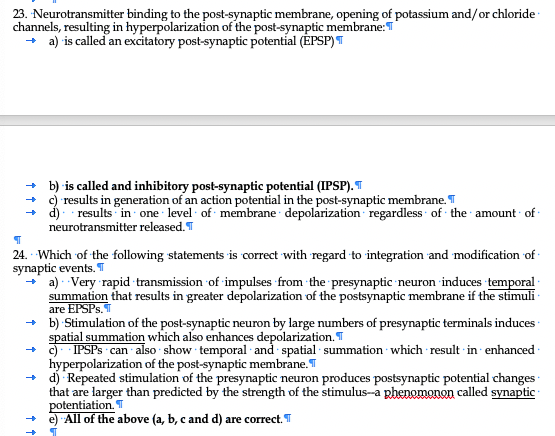23. Neurotransmitter binding to the post-synaptic membrane, opening of potassium and/or chloride channels, resulting in hyperpolarization of the post-synaptic membrane:T a) is called an excitatory post-synaptic potential (ÉPSP) T + b) is called and inhibitory post-synaptic potential (IPSP).T + c) results in generation of an action potential in the post-synaptic membrane. T + d). results in one level of membrane depolarization regardless of the amount of - neurotransmitter released. T 24. Which of the following statements is correct with regard to integration and modification of- synaptic events. T a) - Very rapid transmission of impulses from the presynaptic neuron induces temporal summation that results in greater depolarization of the postsynaptic membrane if the stimuli are EPSPS. - b) Stimulation of the post-synaptic neuron by large numbers of presynaptic terminals induces spatial summation which also enhances depolarization. T + ) IPSPS can also show temporal and spatial summation which result in enhanced hyperpolarization of the post-synaptic membrane. T + dj Repeated stimulation of the presynaptic neuron produces postsynaptic potential changes that are larger than predicted by the strength of the stimulus-a phenomonon called synaptic potentiation. T + e) All of the above (a, b, c and d) are correct. T
23. Neurotransmitter binding to the post-synaptic membrane, opening of potassium and/or chloride channels, resulting in hyperpolarization of the post-synaptic membrane:T a) is called an excitatory post-synaptic potential (ÉPSP) T + b) is called and inhibitory post-synaptic potential (IPSP).T + c) results in generation of an action potential in the post-synaptic membrane. T + d). results in one level of membrane depolarization regardless of the amount of - neurotransmitter released. T 24. Which of the following statements is correct with regard to integration and modification of- synaptic events. T a) - Very rapid transmission of impulses from the presynaptic neuron induces temporal summation that results in greater depolarization of the postsynaptic membrane if the stimuli are EPSPS. - b) Stimulation of the post-synaptic neuron by large numbers of presynaptic terminals induces spatial summation which also enhances depolarization. T + ) IPSPS can also show temporal and spatial summation which result in enhanced hyperpolarization of the post-synaptic membrane. T + dj Repeated stimulation of the presynaptic neuron produces postsynaptic potential changes that are larger than predicted by the strength of the stimulus-a phenomonon called synaptic potentiation. T + e) All of the above (a, b, c and d) are correct. T
Biology: The Dynamic Science (MindTap Course List)
4th Edition
ISBN:9781305389892
Author:Peter J. Russell, Paul E. Hertz, Beverly McMillan
Publisher:Peter J. Russell, Paul E. Hertz, Beverly McMillan
Chapter39: Information Flow And The Neuron
Section: Chapter Questions
Problem 7TYK: Which of the following does not contribute to propagation of action potentials? a. As the area...
Related questions
Question
please answer 23, 24

Transcribed Image Text:23. Neurotransmitter binding to the post-synaptic membrane, opening of potassium and/or chloride
channels, resulting in hyperpolarization of the post-synaptic membrane:T
a) is called an excitatory post-synaptic potential (ÉPSP) T
+ b) is called and inhibitory post-synaptic potential (IPSP).T
+ c) results in generation of an action potential in the post-synaptic membrane. T
+ d). results in one level · of membrane depolarization regardless of the amount of -
neurotransmitter released. T
24. Which of the following statements is correct with regard to integration and modification of -
synaptic events. T
a) - Very rapid transmission of impulses from the presynaptic neuron induces temporal
summation that results in greater depolarization of the postsynaptic membrane if the stimuli -
are EPSPS.
+ b) Stimulation of the post-synaptic neuron by large numbers of presynaptic terminals induces
spatial summation which also enhances depolarization. T
+ ) IPSPS can also show temporal and spatial summation which result in enhanced
hyperpolarization of the post-synaptic membrane. T
+ dj Repeated stimulation of the presynaptic neuron produces postsynaptic potential changes
that are larger than predicted by the strength of the stimulus-a phenomonon called synaptic
potentiation. T
+ e) All of the above (a, b, c and d) are correct. T
Expert Solution
This question has been solved!
Explore an expertly crafted, step-by-step solution for a thorough understanding of key concepts.
Step by step
Solved in 4 steps with 2 images

Recommended textbooks for you

Biology: The Dynamic Science (MindTap Course List)
Biology
ISBN:
9781305389892
Author:
Peter J. Russell, Paul E. Hertz, Beverly McMillan
Publisher:
Cengage Learning

Anatomy & Physiology
Biology
ISBN:
9781938168130
Author:
Kelly A. Young, James A. Wise, Peter DeSaix, Dean H. Kruse, Brandon Poe, Eddie Johnson, Jody E. Johnson, Oksana Korol, J. Gordon Betts, Mark Womble
Publisher:
OpenStax College

Biology 2e
Biology
ISBN:
9781947172517
Author:
Matthew Douglas, Jung Choi, Mary Ann Clark
Publisher:
OpenStax

Biology: The Dynamic Science (MindTap Course List)
Biology
ISBN:
9781305389892
Author:
Peter J. Russell, Paul E. Hertz, Beverly McMillan
Publisher:
Cengage Learning

Anatomy & Physiology
Biology
ISBN:
9781938168130
Author:
Kelly A. Young, James A. Wise, Peter DeSaix, Dean H. Kruse, Brandon Poe, Eddie Johnson, Jody E. Johnson, Oksana Korol, J. Gordon Betts, Mark Womble
Publisher:
OpenStax College

Biology 2e
Biology
ISBN:
9781947172517
Author:
Matthew Douglas, Jung Choi, Mary Ann Clark
Publisher:
OpenStax

Cardiopulmonary Anatomy & Physiology
Biology
ISBN:
9781337794909
Author:
Des Jardins, Terry.
Publisher:
Cengage Learning,